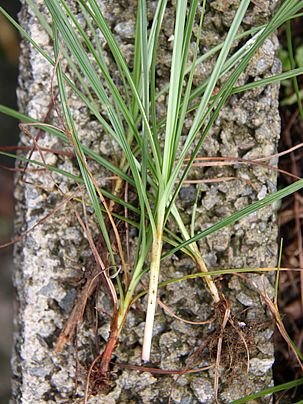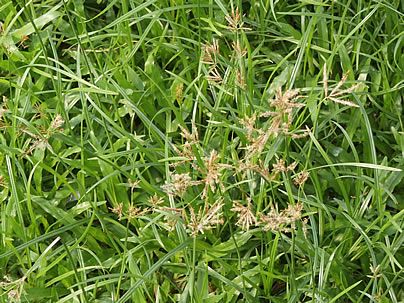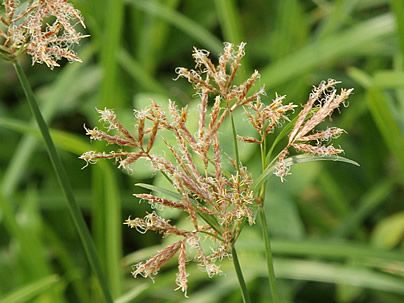Purple Nutsedge (Cyperus rotundus) is a bulbous, herbaceous plant, known for being a weed in lawns, flower beds, and agriculture in general. It is possibly native to India but is now widespread in all tropical and subtropical regions of the planet, including temperate areas. It features linear, intensely green, shiny leaves that emerge from a deep, underground bulb. Rhizomes sprout from each bulb, running parallel to the soil surface, and at small intervals, they form hypertrophied areas that give rise to new bulbs.
Thus, a large area covered by the plant is often actually a single specimen. Over time, these rhizomes naturally break, dividing the individuals. In this way, the plant spreads quickly and persists in the soil for a long time, making it difficult to control. Despite its small size, ranging from 15 to 50 centimeters (6 to 20 inches), Purple Nutsedge can reach about a meter (3.3 feet) deep with its root system. The inflorescences appear at any time of the year and are spikelet type, reddish-brown in color.

Prevention and control of Purple Nutsedge involve constant care of the soil, restoring its fertility, facilitating its drainage, and correcting the pH with limestone, preferably dolomitic. The use of soil covering, either through dense and closed ground cover or with a dead covering, such as straw or sawdust, helps in the prevention and control of this and other invasive plants.
In case of establishing a new garden or lawn over an infested area, it is worth applying a low-residual herbicide, under the strict criterion of an agronomist. After implementation, control methods generally include careful uprooting of the plants, aiming to remove the underground bulbs as much as possible.
Selective herbicides can also be used, targeting Purple Nutsedge without affecting the health of the lawn. Regular mowing of the lawn, besides eliminating the visual effect of Purple Nutsedge, also weakens its structure and favors the densification of the grass.
Tilling the soil is a condemnable practice in controlling Purple Nutsedge, as it further stimulates the growth of buds in the bulbs, increasing their multiplication. Tilling is only valid in areas with prolonged and intense drought, where the bulbs of Purple Nutsedge are subject to desiccation.
In organic, biodynamic, and agroecological gardens, uprooting Purple Nutsedge is crucial in the initial growth phase of the vegetables, avoiding competition. Once the latter are established, coexistence with Purple Nutsedge is peaceful, and depending on the viewpoint, it often becomes even interesting, as they help protect the soil from leaching, for example.

It grows quickly in full sun, preferably in poor, acidic, poorly drained, eroded soils, or with exposed soil. It has a great capacity to tolerate drought, waterlogging, and intense heat. Constant shading and cold weaken the plant, leading to slower growth. It reproduces by seeds but mainly through hypertrophies and underground tubers.
Curiosity: Purple Nutsedges are edible and considered NCEP (Non-conventional Edible Plants). The small bulbs can be eaten raw or cooked, in juices, salads, or other savory dishes. They are also highly appreciated by ducks and mallards.


